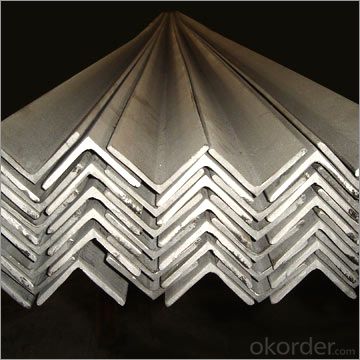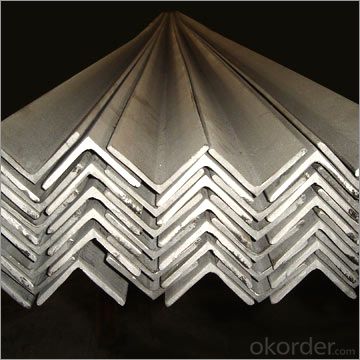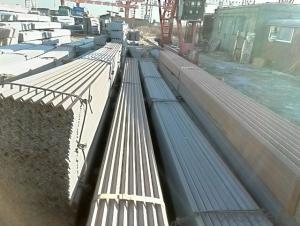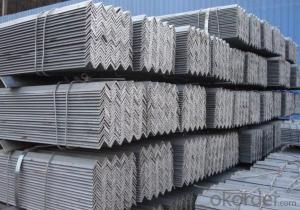Angle Steel and Galvanized Angle Steel High Quality Hot Rolled
- Loading Port:
- Tianjin
- Payment Terms:
- TT or LC
- Min Order Qty:
- 25 m.t.
- Supply Capability:
- 20000000 m.t./month
OKorder Service Pledge
OKorder Financial Service
You Might Also Like
Product Description:
OKorder is offering Angle Steel and Galvanized Angle Steel High Quality Hot Rolledat great prices with worldwide shipping. Our supplier is a world-class manufacturer of steel, with our products utilized the world over. OKorder annually supplies products to European, North American and Asian markets. We provide quotations within 24 hours of receiving an inquiry and guarantee competitive prices.
Product Applications:
According to the needs of different structures, Angle can compose to different force support component, and also can be the connections between components. It is widely used in various building structures and engineering structures such as roof beams, bridges, transmission towers, hoisting machinery and transport machinery, ships, industrial furnaces, reaction tower, container frame and warehouse etc
Product Advantages:
OKorder's Steel I-Beams are durable, strong, and resist corrosion.
Main Product Features:
· Premium quality
· Prompt delivery & seaworthy packing (30 days after receiving deposit)
· Corrosion resistance
· Can be recycled and reused
· Mill test certification
· Professional Service
· Competitive pricing
Product Specifications:
Manufacture: Hot rolled
Grade: Q195 – 235
Certificates: ISO, SGS, BV, CIQ
Length: 6m – 12m, as per customer request
Packaging: Export packing, nude packing, bundled
Sizes: 25mm-250mm | ||||||||||||
a*t | ||||||||||||
25*2.5-4.0 | 70*6.0-9.0 | 130*9.0-15 | ||||||||||
30*2.5-6.6 | 75*6.0-9.0 | 140*10-14 | ||||||||||
36*3.0-5.0 | 80*5.0-10 | 150*10-20 | ||||||||||
38*2.3-6.0 | 90*7.0-10 | 160*10-16 | ||||||||||
40*3.0-5.0 | 100*6.0-12 | 175*12-15 | ||||||||||
45*4.0-6.0 | 110*8.0-10 | 180*12-18 | ||||||||||
50*4.0-6.0 | 120*6.0-15 | 200*14-25 | ||||||||||
60*4.0-8.0 | 125*8.0-14 | 250*25 | ||||||||||
FAQ:
Q1: How do we guarantee the quality of our products?
A1: We have established an advanced quality management system which conducts strict quality tests at every step, from raw materials to the final product. At the same time, we provide extensive follow-up service assurances as required.
Q2: How do you package the angle steel when shipping?
A2: All goods are packed in bundles with steel strips and shipped by container or break bulk.
Q3: How soon can we receive the product after purchase?
A3: Within three days of placing an order, we will begin production. The specific shipping date is dependent upon international and government factors, but is typically 7 to 10 workdays.


- Q: Can steel angles be used in the construction of agricultural buildings?
- Yes, steel angles can definitely be used in the construction of agricultural buildings. Steel angles are a versatile and durable building material that offer several advantages when it comes to constructing agricultural structures. Firstly, steel angles provide excellent structural support and stability. They can be used to create sturdy frameworks for the walls, roofs, and other structural components of agricultural buildings. This is particularly important in agricultural buildings, where heavy machinery and equipment is often stored, and where the structures need to withstand harsh weather conditions and potential impact from animals or other elements. Secondly, steel angles are highly resistant to corrosion and rust, which makes them ideal for agricultural buildings that are exposed to moisture, chemicals, and other potentially corrosive substances. This resistance to corrosion ensures that the structure remains strong and durable over time, reducing the need for frequent maintenance and repairs. Furthermore, steel angles are available in various sizes and shapes, allowing for flexibility in design and construction. They can be easily customized and cut to fit specific building requirements, making them adaptable to various agricultural building designs. Additionally, steel angles can be easily welded or bolted together, making the construction process more efficient and cost-effective. Lastly, steel angles are a sustainable and environmentally friendly choice for agricultural buildings. Steel is a recyclable material, meaning that it can be reused or repurposed once the building has reached the end of its lifespan. This reduces the environmental impact and promotes sustainability in the construction industry. In conclusion, steel angles can be effectively used in the construction of agricultural buildings due to their structural strength, corrosion resistance, design flexibility, and sustainability.
- Q: What are the different testing methods used for quality control of steel angles?
- There are several testing methods used for quality control of steel angles. These include visual inspection, dimensional measurements, ultrasonic testing, magnetic particle inspection, and load testing. Visual inspection involves visually examining the steel angles for any surface defects or imperfections. Dimensional measurements ensure that the angles meet the specified size and shape requirements. Ultrasonic testing uses sound waves to detect any internal flaws or discontinuities in the material. Magnetic particle inspection involves applying a magnetic field to the angles and using magnetic particles to identify any surface cracks or defects. Lastly, load testing involves subjecting the angles to a predetermined load to determine their strength and structural integrity. These testing methods help ensure that the steel angles meet the required quality standards.
- Q: How do you straighten a bent steel angle?
- To straighten a bent steel angle, you can use a combination of manual force and mechanical aids. First, secure the angle in a vice or clamp it to a sturdy surface. Then, gently apply pressure in the opposite direction of the bend using a mallet or hammer. For more complex bends, you may need to use a hydraulic press or a bending machine. It is important to apply gradual force and check the angle's alignment frequently to avoid over-straightening or damaging the steel.
- Q: What are the standard lengths of steel angles?
- The specific requirements and standards of various industries and applications determine the varying standard lengths of steel angles. Typically, these standard lengths range from 20 to 40 feet. These lengths find extensive usage in construction, manufacturing, and structural applications. It is worth mentioning that steel angles can be tailored and adjusted to meet the specific length requirements of a project.
- Q: Can steel angles be welded or joined together?
- Yes, steel angles can be welded or joined together. Welding is a commonly used method to connect steel angles, as it provides a strong and durable bond. The process involves melting the edges of the angles and then fusing them together using a welding electrode. Welding not only creates a secure connection between the steel angles but also ensures structural integrity. It is important to follow proper welding procedures and techniques to ensure the quality and strength of the joint. Additionally, steel angles can also be joined together using other methods such as bolting or riveting, depending on the specific application and requirements.
- Q: What are the properties of steel angles?
- Steel angles, also known as angle iron or L-shaped steel, possess several properties that make them highly versatile and widely used in various industries. 1. Strength and durability: Steel angles are made from solid steel and are known for their exceptional strength and durability. These properties make them suitable for structural applications where high strength is required, such as in building frames and supports. 2. Load-bearing capacity: Due to their L-shaped design, steel angles offer excellent load-bearing capacity. They can efficiently distribute weight and provide structural support, making them ideal for constructing bridges, towers, and other heavy-duty structures. 3. Versatility in applications: Steel angles can be used in a wide range of applications due to their flexibility and adaptability. They can be easily cut, drilled, and welded, allowing for customization to fit specific project requirements. Steel angles are commonly used in the construction, manufacturing, and automotive industries. 4. Corrosion resistance: Steel angles can be manufactured with corrosion-resistant coatings or made from stainless steel, providing protection against rust and other environmental factors. This corrosion resistance makes them suitable for outdoor applications and in environments with high moisture or chemical exposure. 5. Cost-effectiveness: Steel angles are cost-effective compared to other structural materials, such as aluminum or wood. They offer a high strength-to-weight ratio, minimizing the amount of material required for a given application. This makes steel angles a cost-efficient choice for various construction projects. 6. Aesthetics: Steel angles can also be used for their aesthetic appeal, adding a visually appealing dimension to architectural designs. They can be utilized for decorative purposes in interior design or as part of ornamental structures, providing both functionality and visual interest. Overall, the properties of steel angles, including strength, load-bearing capacity, versatility, corrosion resistance, cost-effectiveness, and aesthetic appeal, make them an excellent choice for a wide range of applications in different industries.
- Q: How do steel angles perform under high temperatures?
- Due to their high melting point and exceptional heat resistance, steel angles exhibit excellent performance in high-temperature conditions. Steel, a widely utilized material in construction and engineering, is renowned for its robustness and durability. Steel angles, when subjected to elevated temperatures, maintain their structural integrity and do not easily deform or weaken. This is primarily due to steel's elevated melting point, typically ranging from 1370 to 1530 degrees Celsius (2500 to 2800 degrees Fahrenheit), enabling it to endure extreme heat without significant harm. Moreover, steel possesses outstanding heat resistance, enabling efficient heat dissipation and maintaining stability when confronted with high thermal loads. Consequently, steel angles are suitable for applications involving elevated temperatures, such as industrial furnaces, power plants, or high-temperature environments. However, it is crucial to acknowledge that the specific performance of steel angles under high temperatures can vary depending on the steel's grade and composition, as well as the intensity and duration of heat exposure.
- Q: Are steel angles easy to install?
- Yes, steel angles are generally easy to install. They come in pre-cut lengths with pre-drilled holes, making them convenient for various applications such as construction, framing, or manufacturing. Additionally, they can be easily fastened using screws, bolts, or welding techniques, depending on the specific installation requirements.
- Q: How do you determine the resistance to lateral-torsional buckling of a steel angle?
- There are several factors that need to be taken into account when determining the resistance to lateral-torsional buckling of a steel angle. The primary factors that influence this resistance are the geometric properties of the angle section, the material properties of the steel, and the boundary conditions of the member. 1. Geometric properties: The resistance to lateral-torsional buckling is affected by critical geometric properties such as the length, width, thickness, and slenderness ratio of the angle section. The slenderness ratio, which is the ratio of the length to the radius of gyration of the section, is particularly important as it indicates the stability of the member. A higher slenderness ratio implies a greater susceptibility to lateral-torsional buckling. 2. Material properties: The resistance to lateral-torsional buckling also depends on the material properties of the steel angle. Factors such as the yield strength, modulus of elasticity, and the shape of the stress-strain curve play a significant role in determining the capacity of the steel angle to withstand bending and twisting moments without buckling. 3. Boundary conditions: The resistance to lateral-torsional buckling is significantly influenced by the boundary conditions of the steel angle. The type of support and the loading conditions both play a crucial role. The type of support, whether it is simply supported or fixed, determines the level of rotational and translational constraints on the member. Similarly, the applied loads, such as point loads, distributed loads, or moments, determine the bending and twisting moments that act on the angle section. To determine the resistance to lateral-torsional buckling, engineers typically refer to relevant design codes and standards, such as the AISC Manual or Eurocode. These codes provide design formulas and tables that take into consideration the geometric properties, material properties, and boundary conditions. They allow engineers to calculate the critical moment and corresponding resistance to lateral-torsional buckling for the steel angle. Additionally, advanced computer simulations, such as FEA software, can be used to obtain more accurate results by considering complex loadings and boundary conditions.
- Q: Can steel angles be used as reinforcement in concrete slabs?
- Concrete slabs can indeed benefit from the use of steel angles for reinforcement. These L-shaped structural steel components, commonly utilized in construction due to their durability and strength, can significantly enhance the load-bearing capacity of a concrete slab. Furthermore, they help prevent any potential cracks or structural failure. Specifically, steel angles provide added support and strength to the concrete, especially in areas where heavy loads or concentrated forces are anticipated. By incorporating steel angles as reinforcement, the concrete slab becomes more resistant to bending, tension, and shearing forces, resulting in a structurally sound slab that can withstand higher loads. It is crucial to ensure the proper design and placement of steel angles, following the guidelines and specifications provided by structural engineers, to guarantee the optimal reinforcement and performance of the concrete slab.
Send your message to us
Angle Steel and Galvanized Angle Steel High Quality Hot Rolled
- Loading Port:
- Tianjin
- Payment Terms:
- TT or LC
- Min Order Qty:
- 25 m.t.
- Supply Capability:
- 20000000 m.t./month
OKorder Service Pledge
OKorder Financial Service
Similar products
Hot products
Hot Searches
Related keywords



























